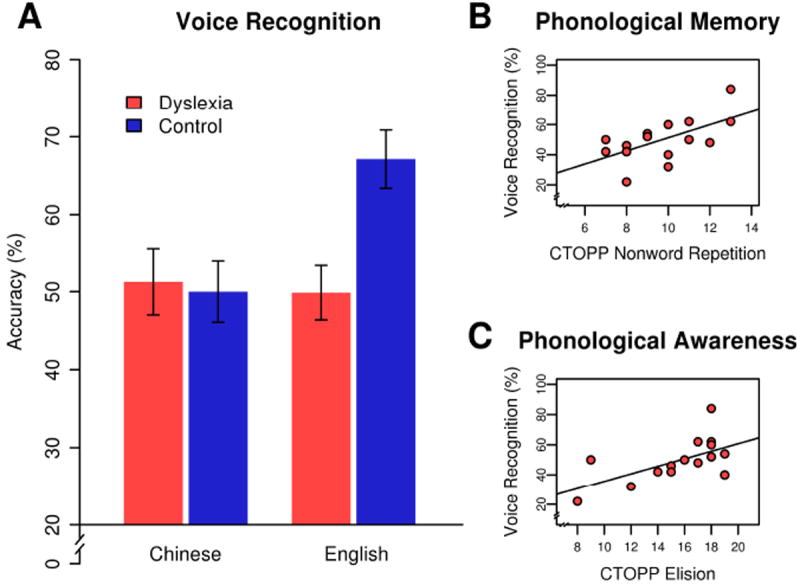Abstract
The ability to recognize people by their voice is an important social behavior. Individuals differ in how they pronounce words, and listeners may take advantage of language-specific knowledge of speech phonology to facilitate recognizing voices. Impaired phonological processing is characteristic of dyslexia and thought to be a basis for difficulty learning to read.
We tested voice-recognition abilities of dyslexic and control listeners for voices speaking listeners’ native language or an unfamiliar language. Individuals with dyslexia exhibited impaired voice-recognition abilities compared to controls only for voices speaking their native language. These results demonstrate the importance of linguistic representations for voice recognition. Humans appear to identify voices by making comparisons between talkers’ pronunciations of words and listeners’ stored abstract representations of the sounds in those words.
The ability to recognize individual conspecifics from their communicative vocalizations is an adaptive trait evinced widely among social and territorial animals, including humans. Studies of human voice recognition compare this ability to nonverbal processes, such as human perception of faces or nonhuman animals’ perception of vocalizations (1). However, the human voice is also the principal medium for the human capacity of language, as conveyed through speech. Human listeners are more accurate identifying voices when they can understand the language being spoken (2), an advantage thought to depend on listeners’ knowledge of phonology – the rules governing sound structure in their language. Leading theories of dyslexia propose that impoverished phonological processing often underlies impaired reading ability in this disorder (3,4). We therefore hypothesized that if voice recognition by human listeners relies on linguistic (phonological) representations, listeners with dyslexia would be impaired compared to control participants when identifying voices speaking their native language (due to impaired phonological processing), but unimpaired in voice recognition for an unfamiliar, foreign language (where both individuals with and without dyslexia lack relevant language-specific phonological representations).
We assessed participants with and without dyslexia for their ability to learn to recognize voices speaking either the listeners’ native language (English) or an unfamiliar, foreign language (Chinese). In each language, participants learned to associate five talkers’ voices with unique cartoon avatars and were subsequently tested on their ability to correctly identify those voices. The participants’ task was to indicate which of the five talkers spoke in each trial (five-alternative forced-choice; chance = 20% accuracy (5)). Despite using the same vocabulary, speakers of a language all differ in their pronunciations of words (6), and listeners can use their phonological abilities to perceive these differences as part of a speaker’s vocal identity. A repeated-measures analysis of variance revealed that, compared to controls, dyslexic participants were significantly impaired at recognizing the voices speaking English, but unimpaired for those speaking Chinese (group × condition interaction, P < 0.0006) (Figure 1).
Fig. 1.

(A) Mean voice recognition performance of dyslexic and control listeners (error bars: standard error of the mean). All individuals scored above chance (20%), shown as baseline. (B,C) Relationships between clinical measures of language (phonological) ability in dyslexia and voice recognition ability.
English-speaking listeners with normal reading ability were significantly more accurate identifying voices speaking English than Chinese (paired t-test, P < 0.0005), performing on average 42% better in their native language (6). English-speaking listeners with dyslexia were no better able to identify English-speaking voices than Chinese-speaking ones (paired t-test, P = 0.65), with an average performance gain of only 2% in their native language. Correspondingly, dyslexic listeners were significantly impaired compared to controls in their ability to recognize English-speaking voices (independent-sample t-test, P < 0.0021). Dyslexic listeners were as accurate as controls when identifying the Chinese-speaking voices (independent-sample t-test, P = 0.83), demonstrating that their voice-recognition deficit was not due to generalized auditory or memory impairments. Moreover, for the dyslexic participants, greater impairments on clinical assessments of phonological processing were correlated with worse accuracy for identifying English-speaking voices (both Pearson’s r > 0.6, P < 0.015). Although the diagnostic criterion for dyslexia is impairment in developing typical reading abilities, these data show that reading difficulties are accompanied by impaired voice recognition. This inability to learn speaker-specific representations of phonetic consistency may reflect a weakness in language learning that contributes to impoverished long-term phonological representations in dyslexia.
For humans, the ability to recognize one another by voice relies on the ability to compute the differences between the incidental phonetics of a specific vocalization and the abstract phonological representations of the words that vocalization contains. When the abstract linguistic representations of words are unavailable (because the stimulus is unfamiliar, as in foreign-language speech) or impoverished (because native language phonological representations are compromised, as in dyslexia) the human capacity for voice recognition is significantly impaired. This reliance on our faculty for language distinguishes human voice recognition from the recognition of conspecific vocalizations by other non-human animals.
Supplementary Material
Acknowledgments
We thank J.A. Christodoulou, E.S. Norton, B. Levy, C. Cardenas-Iniguez, J. Lymberis, P. Saxler, P.C.M. Wong, C.I. Moore, and S. Shattuck-Hufnagel. This work was supported by the Ellison Medical Foundation and NIH grant UL1RR025758. TP is supported by a NSF Graduate Research Fellowship.
References
- 1.Belin P, Fecteau S, Bedard C. Trends Cognit Sci. 2004;8:129. doi: 10.1016/j.tics.2004.01.008. [DOI] [PubMed] [Google Scholar]
- 2.Perrachione TK, Wong PCM. Neuropsychologia. 2007;45:1899. doi: 10.1016/j.neuropsychologia.2006.11.015. [DOI] [PubMed] [Google Scholar]
- 3.Bradley L, Bryant PE. Nature. 1983;301:419. [Google Scholar]
- 4.Gabrieli JDE. Science. 2009;325:280. doi: 10.1126/science.1171999. [DOI] [PubMed] [Google Scholar]
- 5.Materials and methods are available as supporting material on Science Online.
- 6.Hillenbrand J, et al. J Acoust Soc Am. 1995;97:3099. doi: 10.1121/1.411872. [DOI] [PubMed] [Google Scholar]
- 7.Native Chinese-speaking controls exhibit the opposite pattern, recognizing Chinese-speaking voices more accurately than English-speaking ones (2), revealing the critical factor to be listeners’ language familiarity, not properties inherent to the voice stimuli or languages themselves.
Associated Data
This section collects any data citations, data availability statements, or supplementary materials included in this article.


